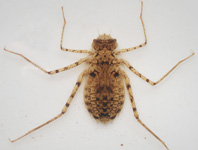Abstract
The final stadium larva of Macromia calliope Ris is described and illustrated for the first time and diagnosed against other larvae of Chinese Macromia species on the basis of published descriptions. Among the fourteen known Chinese Macromia larvae, that of M. calliope can be separated from those of non-calliope-group species by having distinctive diamond-shaped black spots located at the outside of the base of the wing sheaths. And in five Chinese calliope-group species, the larva of M. calliope can be separated from that of M. flavocolorata by apical border of prementum not obviously projecting forwards; from that of M. septima by dorsal hook on S3 thinnest and tallest of all; from that of M. chui by a relatively smaller body; from that of M. urania by nine premental setae on each side of interior prementum, five longer ones accompanied medially by four shorter ones; and finally, from those of all other Chinese Macromia species by several distinctive large V-shaped black markings on mid-dorsum of distal abdominal segments.
References
Lieftinck, M.A. (1929) A revision of the known Malaysian dragonflies of the genus Macromia Rambur, with comparative notes on species from neighbouring countries and descriptions of new species. Tijdschrift voor Entomologie, 72, 59–108.
Lieftinck, M.A.(1950) Further studies on southeast Asiatic species of Macromia Rambur, with notes on their ecology, habitats and life history, and with descriptions of larvae and two new species (Odon: Epophthalmiinae). Treubia, 20, 657–716.
Lieftinck, M.A. (1955) Further inquiries into old world species of Macromia Rambur (Odonata). Zoologische Mededelingen, 33 (25), 251–277.
Matsuki, K. & Lien, J.C. (1982) Descriptions of the larvae of two Macromia species in Taiwan. Tombo, 25 (1/4), 19–22.
Schorr, M. & Paulson, D. (2015) World Odonata list. Available from: http://www.pugetsound.edu/academics/academic-resources/slater-museum/biodiversity-resources/dragonflies/world-odonata-list2/ (Accessed 12 August 2015)
Needham, J.G. (1930) A manual of the dragonflies of China. Zoologia Sinica,11, i-xi, 1–344.
Ris, F. (1916) H. Sauter's Formosa-Ausbeute. Odonata (Mit Notizen über andere ostasiatische Odonaten). Supplementa Entomologica, 5, 1–81.
Watson, M.C. (1956) The utilization of mandibular armature in taxonomic studies of anisopterous nymphs. Transactions of the American Entomological Society, 81, 155–202.
Wilson, K.D.P. & Reels, G.T. (2001) Odonata of Hainan, China. Odonatologica, 30 (2), 145–208.
Wilson, K.D.P. & Theischinger, G. (1996) Further notes on Macromia Rambur from Hong Kong, with descriptions of the larvae (Anisoptera: Corduliidae). Odonatologica, 25 (3), 275–282.
Wu, H.-D. (2012) Huizhou dragonflies. China Forestry Press, Beijing, 188 pp.
Xu, Q.-H. (2010) The larvae of Macromia flavocolorata and M. septima from Fujian, China (Odonata: Macromiidae). International Journal of Odonatology, 13 (1), 145–152.
http://dx.doi.org/10.1080/13887890.2010.9748368Xu, Q.-H. (2014) The resources of odonates from Zhangzhou, Fujian of China. Wuyi Science Journal, 30, 63–73.
Zhang, H.-M. (2012) Systematic Study of Anisoptera Larvae in China (Insecta: Odonata) (Doctor thesis), College of Natural Resources and Environment, South China Agricultural University, China.

